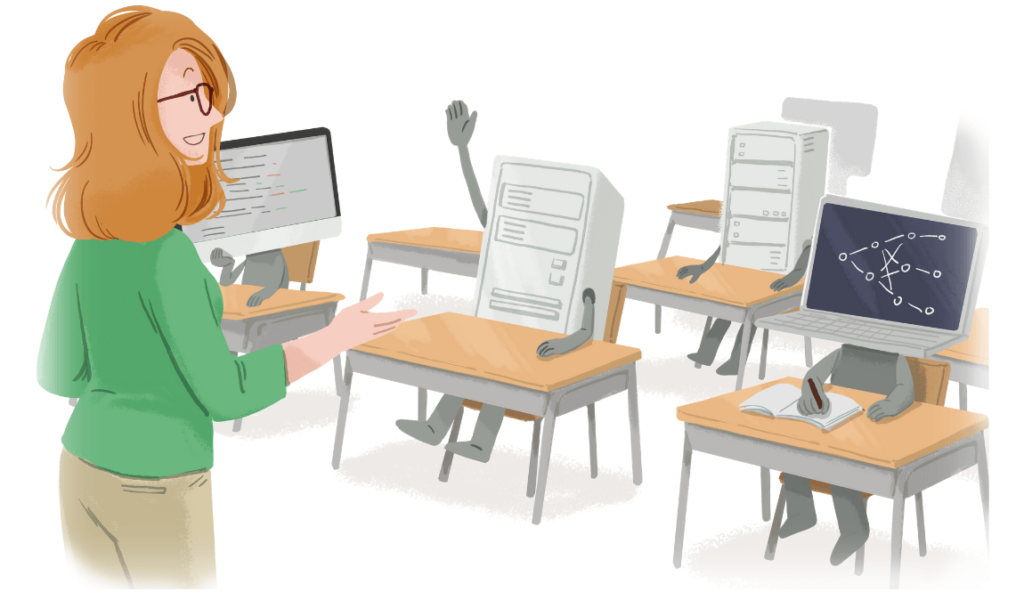AI in education is more than science fiction. One study found that 34 hours on Duolingo’s app are equivalent to a full university semester of language education. But educational AI and the broader category of educational technology (EdTech) go well beyond language learning. Companies like Carnegie Learning and Fuel Education apply artificial intelligence to K-12 learning. One of the most popular EdTech platforms, McGraw Hill’s ALEKS, is a web-based, AI-powered assessment and learning system that covers K-12, homeschool and even college content.
As with many other artificial intelligence domains, China has already leapt to the front of the pack in in advancing AI-centered education. But the United States is taking steps to put AI in the classroom, too. Meanwhile, many leading AI ethicists are raising alarms.![[machine learning model with tongue.png]](https://www.lexalytics.com/wp-content/uploads/2022/04/02-e1553548544719-300x250.png)
I did some research into the role of AI in the classroom now, what the future holds for AI in education, and the ethical side of things.
Here’s what I found.
The Foundation of AI in Education: Knowledge Space Theory
AI in education generally focuses on identifying what a student does and doesn’t know through diagnostic testing and then developing personalized curricula based on each student’s specific needs. According to Derek Li, founder of Chinese EdTech unicorn Squirrel AI, “In three hours we understand students more than the three years spent by the best teachers” — more on this in a bit.
Many EdTech companies, including Squirrel AI, train their AI learning platforms using Knowledge Space Theory (KST). Knowledge Space Theory “applies concepts from Combinatorics and stochastic processes to the modeling and empirical description of particular fields of knowledge.”
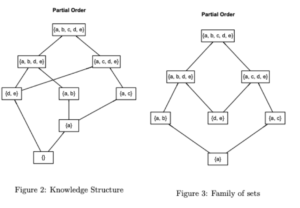
In simpler terms: Knowledge Space Theory uses mathematical language to define and track “knowledge points”. These points form a comprehensive picture of an individual’s “knowledge state” for a particular subject.
There’s lots of complex math that goes into KST, but we’ll leave it there. This April 2019 research paper by Christina Stahl and Cord Hockemeyer offers more detail for the technically-inclined.
One of the Most Popular EdTech Systems Demonstrates the Strengths and Weaknesses of the AI-Based Approach
Assessment and Learning in Knowledge Space, ALEKS, is a popular online learning platform with courses spanning K-12 through higher education. Students start with an ALEKS Assessment to gauge their current knowledge on a range of subjects. Based on their responses, ALEKS claims to gain a precise picture of the student’s level of understanding. When the student enters Learning Mode, the system then uses their assessment adjust its curriculum to fill in their knowledge gaps.
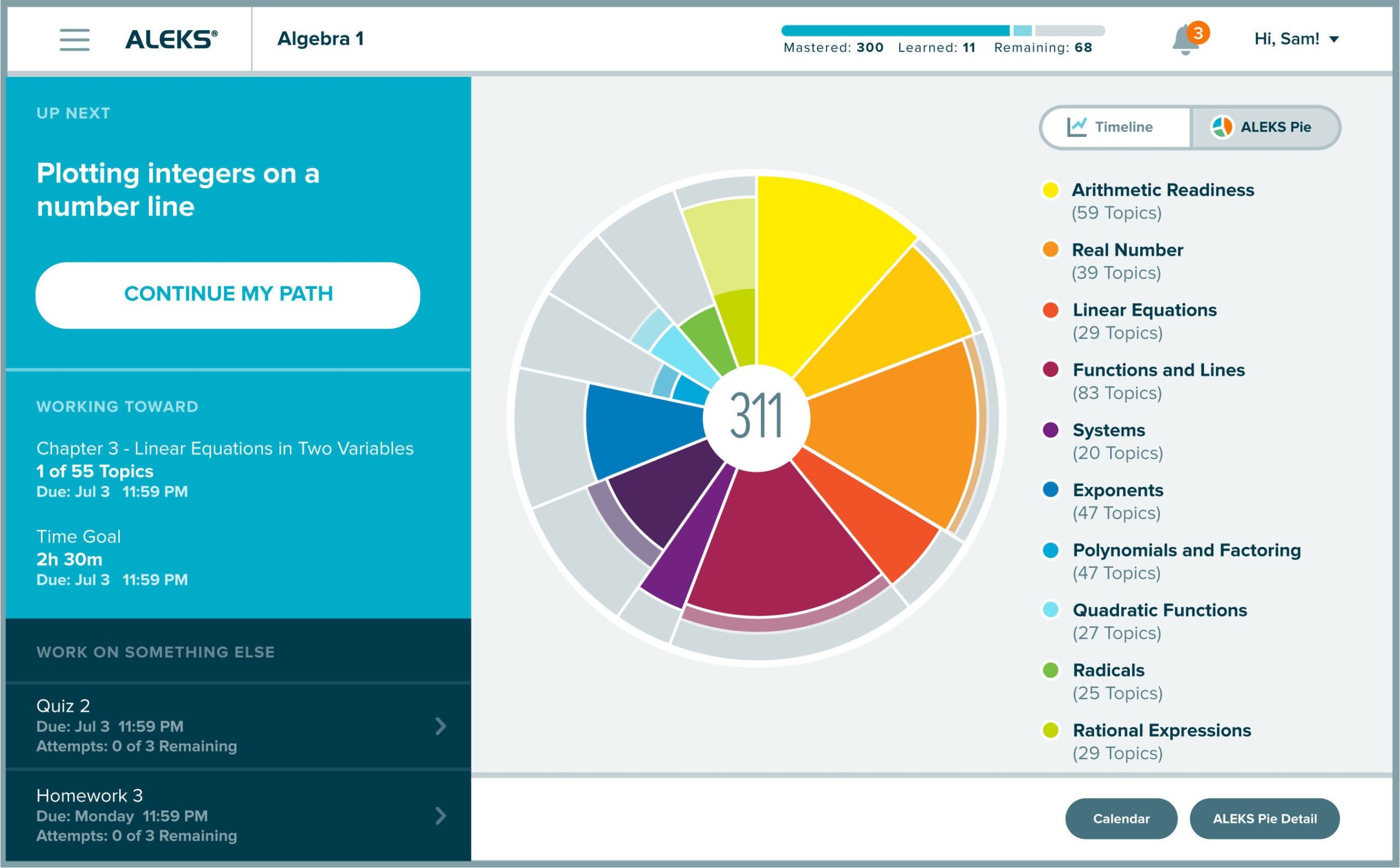
Once a student gives consistently correct answers, they move on to the next topic and ALEKS updates their map of the student’s knowledge state. Additionally, ALEKS periodically reassesses the student on prior topics to ensure long term memory retention. According to McGraw Hill, current owners of ALEKS, “Because students are forced to show mastery through mixed-question assessments that cannot be predicted, mastery of an ALEKS course means true mastery of the course.”
But Knowledge Space Theory and ALEKS aren’t without controversy. After all, I’d argue that there are infinite possible “knowledge states” for a subject. But the ALEKS Assessment is usually just 20-30 questions long. How can they claim to accurately measure someone’s knowledge state from such a small number of questions?
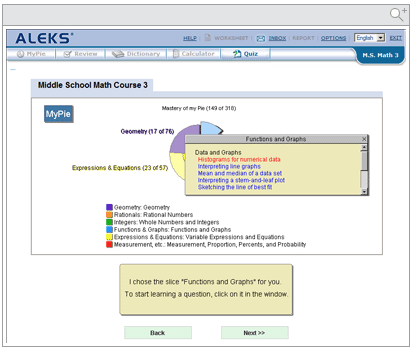
In fact, you don’t have to look far to find documented performance discrepancies. According to EdSurge, ALEKS created higher performance in a mid-sized midwestern city but not in smaller towns. The same article also points out that Dreambox Learning, an online math learning platform, “was associated with higher learning outcomes in a mid-sized city in the Midwest, but not in a similar neighboring city.”
Zooming Out: China is Investing Heavily in AI for Education
Let’s back up for a moment. China is investing billions in artificial intelligence, and a substantial portion centers around education technology. According to predictions from one report, “AI adoption in education will explode over the next five years and is expected to reach global expenditure of $6b by 2025. Much of the growth will come from China followed by the USA, together accounting for over half of the global AI education spend.”
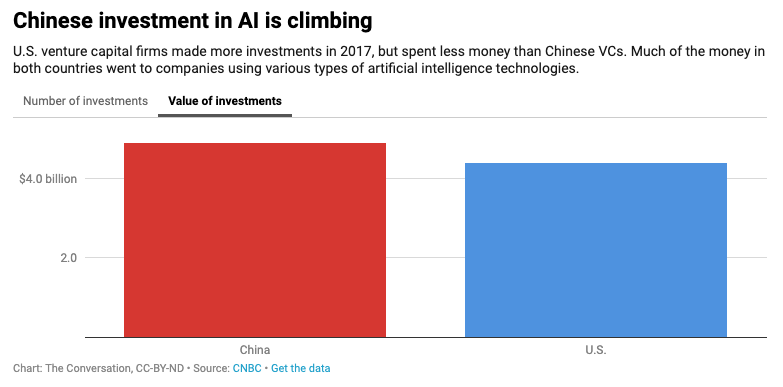
Aside from government support, Chinese EdTech firms are also buoyed by heavy spending from the Chinese middle class. The importance of education in Chinese culture has deep roots. One study, detailed in the South China Morning Post, highlights that families with preschoolers spent on average 26 percent of their income on education, and families with K12 children spent 20 percent of their income on education-related expenses.
Just this past summer, Carnegie Mellon University and Chinese ed-tech firm Yixue Education Inc. announced a research partnership. In their words, “The CMU-Squirrel AI Research Lab on Personalized Education at Scale will develop new ways for AI, machine learning, cognitive science and human computer interface technologies to improve the adaptive learning experiences of K-12 students around the world.” Yixue, through the Squirrel AI Learning brand, has opened over 1,700 AI-driven learning centers across China and has plans to open more. And keep in mind, this is only one of China’s many EdTech firms.
China Is a Battleground for AI-Led versus AI-Assisted Education
Why did I switch gears to talking about China? As it turns out, the country of 1.4 billion is something of a battleground for two competing approaches to AI in education: AI-led versus AI-assisted.
No company better demonstrates this first approach than Squirrel AI. Founded in 2014, Squirrel claims to be “the first pure-play AI-powered adaptive education provider in China”.
Squirrel works with highly-skilled teachers to divide subjects into the smallest possible conceptual blocks of material. For example, Squirrel breaks down middle school-level math into more than 10,000 knowledge points (remember Knowledge Space Theory?). The idea is that this level of granularity allows Squirrel to “diagnose” a student’s knowledge gaps more precisely than anyone else.
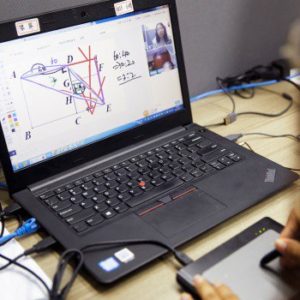
“By comparison,” writes Karen Hao in her fantastic MIT Technology Review article, “a textbook might divide the same subject into 3,000 points; ALEKS, an adaptive learning platform developed by US-based McGraw-Hill, which inspired Squirrel’s, divides it into roughly 1,000.”
Squirrel AI founder Derek Li envisions a classroom where human teachers play a relatively passive role. In his vision, the AI takes care of the actual teaching, and humans only step in when there are problems.
But Squirrel AI isn’t the only player in the Chinese EdTech space. ALO7 exemplifies the other approach: AI-assisted education. Pan Pengkai, founder and CEO, built an English language-learning platform that uses AI to enhance the classroom experience.
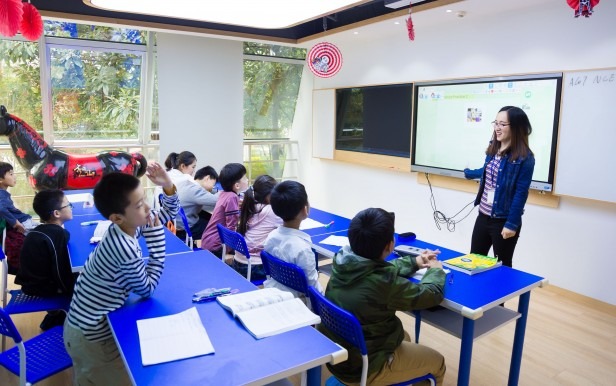
Describing ALO7’s approach, Karen Hao writes, “Knowledge that can be exercised through adaptive learning, like vocabulary words, is practiced at home through the app. So are skills like pronunciation, which can be refined through speech-recognition algorithms. But anything requiring creativity, like writing and conversation, is learned in the classroom.”
In other words: where Squirrel aims to all-but-replace human teachers, ALO7 tries to help them.
American and European Companies Are Also Stepping Up with AI-Powered EdTech
Of course, China isn’t the only country investing in EdTech. Analysts report that AI usage in U.S. education will grow 47.77% from 2018-2022. And U.S. AI startups received a record-high $9.3 billion in venture funding in 2018.
So, how is the rest of the world approaching AI for education? I found many American and European companies favoring an AI-assisted approach.

One such company, Carnegie Learning, has already won three awards (in 2019 alone) for their AI-based education platform for K-12 mathematics. The Carnegie team believes that “all teachers can successfully and effectively teach math with the proper resources and support to build cultures of collaborative learning.” In their view, human teachers are still the most important ingredient to learning. This sounds a lot like ALO7’s approach: AI used as a tool to support a human teacher in the classroom.
Meanwhile, in Sweden, Sana Labs takes an entirely different approach to building AI for education. Rather than creating their own EdTech platform, Sana actually helps other companies personalize education by taking care of the AI and machine learning side of things. 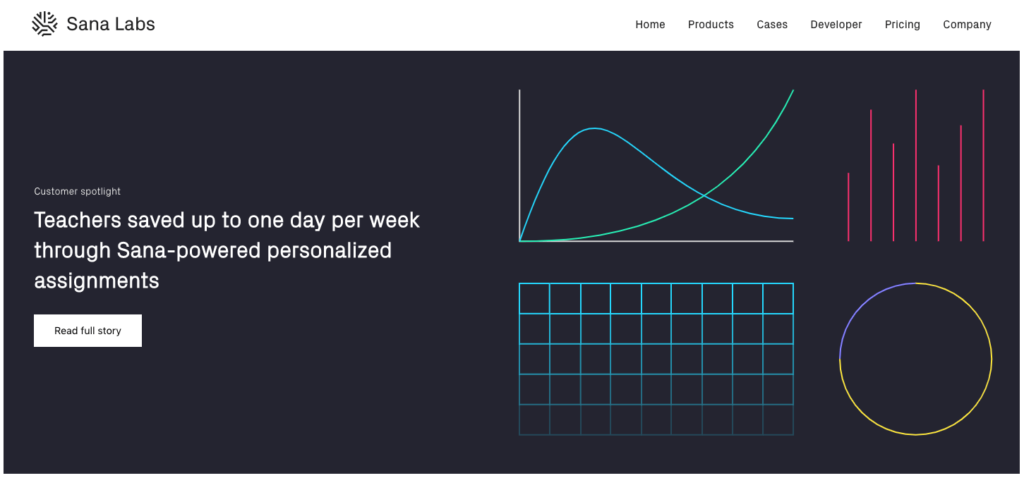
In contrast with companies like Dreambox Learning, who specialize in one subject, Sana covers several fields: mathematics, language learning, and professional education. For a Southeast Asian education company, Sana built a personalized homework system. For another customer in finance exam preparation, Sana provides personalized review sessions that suggest the best next steps for each individual student.
Both of these customer case studies from Sana Labs demonstrate an ALO7-like approach: using AI to free up teachers’ time and personalize education without removing the human element.
A Quick Tangent: Duolingo and AI Cooperation
Switching gears for a moment, I’d like to talk about Duolingo. The language learning app boasts more than three hundred million users enjoying 90 courses in 22 languages. This userbase creates the world’s largest collection of language-learning data – a veritable treasure-trove.
Of course, Duolingo uses this data to continually improve their own product. But they aren’t just hoarding it for themselves. Instead, they’ve “committed to sharing our data and findings with the broader research community”.
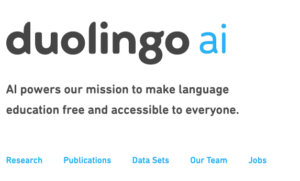
Both individually and as a community, the Duolingo team works “to build unique systems and uncover new insights about the nature of language and learning.” Through their research hub, ai.duolingo.com, they share publications and data sets so that others can build off their work.
In a world where AI development is often framed as an “arms race“, it’s nice to see more examples of companies choosing cooperation and openness over antagonism and close-mindedness.
We Can’t Forget the Ethical Side of AI in Education
Clearly, AI-powered EdTech is already here to stay. But the state of AI in education isn’t all positive. Earlier, I mentioned performance discrepancies between school districts using ALEKS. That’s just the tip of the iceberg.
In late August of this year, a Motherboard investigation found that automated essay-scoring systems are easy to fool with gibberish and grade Chinese and African-American students differently..
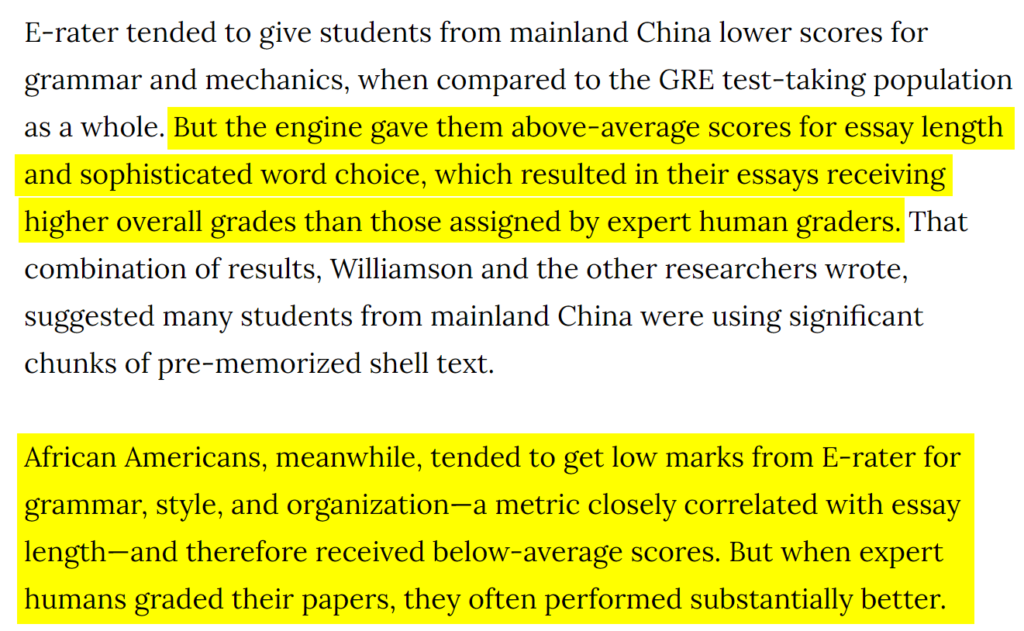
The system in question, E-rater, gave students from mainland China higher overall grades than those given by expert human graders. Meanwhile, E-rater gave African American students poorer marks than they received from human graders.
In their research, Motherboard replicated an MIT experiment by feeding the GRE’s online ScoreItNow! practice tool, which uses E-rater, with two “meaningless gibberish” essays created by the Basic Automatic B.S. Essay Language (BABEL) generator. I think Tom Feathers, writing for Motherboard, describes the outcome best:
Both received scores of 4 out of 6, indicating the essays displayed “competent examination of the argument and convey(ed) meaning with acceptable clarity.”
Here’s the first sentence from the essay addressing technology’s impact on humans’ ability to think for themselves: “Invention for precincts has not, and presumably never will be undeniable in the extent to which we inspect the reprover.”
How does this happen? It turns out that these scoring algorithms don’t try to analyze the actual quality of the writing. Instead, they’re fed with big collections of human-graded essays. Using this data, the algorithms try to identify patterns that correlate with higher or lower grades.
Do Your Part to Fight Back Against Biased AI in Education
This is a known problem: AI systems learn and amplify human biases. In this case, when an AI-powered EdTech system was trained on data annotated by humans, the humans’ biases tainted the data, which in turn infected the algorithms, which in turn produced biased outcomes.
At the end of this chain: a GRE essay-grading system that, without changes, could perpetuate institutional racism that first manifested in how a group of anonymous humans graded a miscellaneous set of essays.
What can we do to reduce the impact of AI bias in education? For one thing, keep humans in the loop. The GRE’s grading, for example, would be even more biased if no humans were involved.
As Motherboard writes, “All essays scored by E-rater are also graded by a human and discrepancies are sent to a second human for a final grade. Because of that system, ETS does not believe any students have been adversely affected by the bias detected in E-rater.”
Beyond that, fighting back against bias in AI starts with you. Educate yourself about where AI bias comes from, and then spread that awareness to others. Challenge your own ideas about how and where we should use AI. Encourage your own company to take measures against biased data. And lobby your government to regulate data collection and AI usage.
The Future of Education is AI-Assisted, not AI-Led
When asked about what Squirrel AI could do to improve, the reply from one student was, “I wish we had more interaction with our human teachers.”
Indeed, most experts agree that the most promise lies in AI-assisted teachers – not AI-led classrooms.
Companies like Carnegie Learning, ALO7 and Sana Labs show how AI can help adapt to individual student needs, free up teacher time by streamlining administrative tasks, and more.
For example, it would be near impossible for a teacher to create personalized learning plans for 20+ students at a time. But AI-based learning systems can do this in minutes.
…anything requiring creativity, like writing and conversation, is learned in the classroom.”
Adaptive learning processes can accommodate learning differences, aid students that fall behind, and help bring students or who have attendance issues back up to speed. AI may even eventually help normalize differences between school districts and even traditional grade levels.
In fact, there is, and should always be, a leading role for humans in the classroom. Writing for The Australian Association for Research in Education, Neil Selwyn points to six aspects of teaching that humans can still do far better than computers:
- Teach from their own experience
- Make cognitive connections
- Make social connections
- Talk out loud
- Perform with their bodies
- Improvise and “make do”
The future of artificial intelligence in education is not a competition between humans and computers to see who can teach the best. Instead, just as with so many other industries, the role of AI is to empower humans to teach and learn more effectively than ever before.
AI in Education: Where to Learn More
The article you just read is almost 2,500 words long. Yet it barely scratches the surface of how AI in education is evolving. If you’d like to dive deeper, here are a few more articles we recommend:
China has started a grand experiment in AI education. It could reshape how the world learns. – MIT Technology Review
Flawed Algorithms Are Grading Millions of Students’ Essays – MotherBoard
Why Aren’t Schools Using the Apps They Pay For? – EdSurge
AI in schools — here’s what we need to consider – The Conversation
Examples of Artificial Intelligence in Education – Emerj
‘It’s an educational revolution’: how AI is transforming university life – The Guardian
